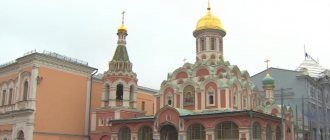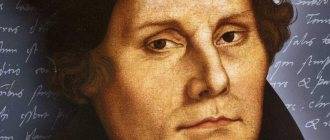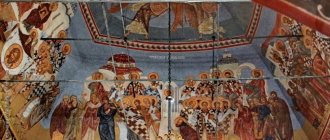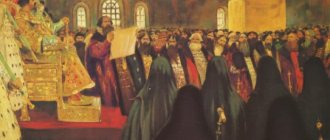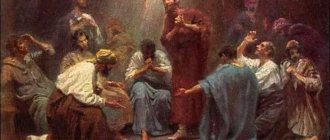Life of Saint Photius, Metropolitan of Moscow
Saint Photius, Metropolitan of Kiev and All Rus', was a Greek from the Peloponnesian city of Monemvasia (Malvasia). Even in his adolescence, he entered a monastery and was tonsured by Elder Akakios (later Metropolitan of Monemvasia). In 1408, when Photius was in Constantinople with the patriarch on an assignment from the metropolitan, the question arose about replacing the Russian see after the death of St. Cyprian. The choice of Patriarch Matthew fell on Photius, known for his learning and pious life. Soon he would have been appointed metropolitan: “in the month of September 1410, on the 1st day, Metropolitan Photius, appointed by Matthew, Patriarch of Constantinople, came from Constantinople to the Russian land to Kiev, received him with great joy and love, with great honors, all Russian princes and boyars, and ordinary people, there was joy about this throughout the country.”[].
Photius spent six months in Kyiv, organizing the affairs of the southern dioceses of the Church, which were then part of the Principality of Lithuania, or rather, as it was called, Lithuanian and Russian. The saint saw that the metropolitan throne - the spiritual focus of the church life of Rus' - could not be located in the land of Kyiv, which was increasingly dependent on Catholic Poland. Following the example of previous Russian metropolitans, who moved their residence first to Vladimir and then to Moscow, Metropolitan Photius arrived in Moscow on Easter Day.
For 22 years the Metropolitan labored in the arduous service of the Primate of the Church. In the difficult conditions of wars, internecine wars, and predatory raids of the Tatars, he managed to highly raise the spiritual significance, material security and splendor of the churches of the Moscow See. The welfare of the Church allowed Bishop Photius to provide great assistance to the impoverished Patriarchate of Constantinople and to strengthen the international significance of the Russian Orthodox Church and the Russian state.
Through the efforts of Metropolitan Photius, the prayerful and canonical unity of the Russian Church was restored: a separate Lithuanian metropolitanate, established at the insistence of Prince Vytautas for the southern and western Russian Orthodox dioceses, was abolished in 1420. The same year, the Bishop visited the returned dioceses and greeted the flock with an extensive teaching message. The wise and highly educated shepherd left many teachings and messages. His denunciations of the Strigolnik heresy that arose in Pskov even before his reign were of great theological significance. Through the efforts of the wise saint, the heresy ceased (in 1427).
Important church-historical sources are the “ Rite of Election and Installation of Bishops ” compiled by Saint Photius (1423), “ Teaching on the Importance of the Holy Order and the Duties of the Clergy ,” as well as the “ Spiritual Testament ,” which tells about his life. The great work of the saint was also the compilation under his leadership of the All-Russian Chronicle Code (around 1423).
On April 20, 1430, the bishop was notified by an angel of his impending death and reposed on July 2, 1431.
Patriarch Photius. The question of the procession of the Holy Spirit.
Saint Photius, Patriarch of Constantinople, politician, scientist and theologian, is perhaps one of the largest figures of the Byzantine period in the history of the Church. The date of his birth is unknown, but he died around 890. He came from a rich and noble family and received an excellent education. His career began in public service in the highest spheres; it is known that he traveled on a diplomatic mission to the court of the Arab caliph. It is not known whether he officially taught at the University of Constantinople, but he had students, and his house was the center of the vibrant intellectual life of the capital. In 858, Photius, while still a layman, was elevated to the patriarchal throne, passing in six days successively through all the lower degrees of the priesthood from reader to bishop. There was nothing unusual in the fact that a layman was elected patriarch - history knows many such cases (Tarasius, Nikephoros, Ambrose of Milan). From the very beginning, the patriarchate of Photius was marked by unrest and unrest. Supporters of Patriarch Ignatius, Photius' predecessor, considered him a usurper. In 859, a council was held in Constantinople, convened to condemn the Ignatians, and they, taking advantage of the right of appeal to the Pope (on the basis of the Council of Serdica), began to demand the convening of another council, which took place in 861. This council, which was attended by papal legates, recognized the election of Photius as legal. Both councils of 859-861 remained in history under the name of the First and Second Council.
When the legates returned to Rome with their news, Pope Nicholas disavowed them and declared the decisions of the council illegal (863). Thus took place the first formal split between East and West.
In 862, even before the schism, Photius wrote a letter to the pope preaching the need for open-mindedness. The letter discussed the situation in Bulgaria, where at that time missionary activity was flourishing, carried out by competing Byzantine and Western missionaries. In this regard, Photius outlined his views on the legality of local customs, which, in his opinion, deserve respect insofar as they do not violate the unity of faith. The schism nevertheless took place, and in 866 Photius sent a circular letter to the Eastern patriarchs, in which, along with other objections to Latin customs, dogmatic arguments against the Filioque were set out for the first time. In 867, another council was held in Constantinople, at which the triumphant party of Photius declared Pope Nicholas deposed. However, a few weeks after this, a palace coup took place in the capital, as a result of which Photius had to resign from the patriarchate. In 869-870, at the insistence of Rome, another council was held in Constantinople, which the Roman Church considers the eighth Ecumenical Council. This council condemned Photius and restored Ignatius to the patriarchal throne. This victory again turned out to be short-lived. The majority of the population and clergy were on the side of Photius, whose humiliation in the eyes of everyone was tantamount to the humiliation of the East before Rome. Photius's influence at court increased, and shortly before Ignatius's death, his reconciliation with Photius took place. Immediately after the death of his former enemy, Photius ascended the patriarchal throne for the second time (877). At the council of 879-880, Photius and his supporters again triumphed. Formally, this council looks like an ecumenical council: it was attended by the legates of Pope John VIII, who made a weak attempt to get an apology from Photius for the deposition of Pope Nicholas. But the Byzantines did not express any regrets, and, moreover, the council officially approved the illegality of any additions to the Creed, thereby condemning the Filioque. In the West, this council was first recognized as ecumenical, but later, in the 11th century, under Gregory VII Hildebrand, the decisions of the council turned out to be unacceptable, and instead the council of 869-870, which condemned Photius and restored Ignatius, began to be considered ecumenical.
After this, Photius reigned for another six years and distinguished himself as an energetic and active patriarch. Having not gotten along with Emperor Leo VI, he retired in 886. Major works of Photius
1. “The Library” - a large work of significant scientific interest, was written even before Photius became patriarch. The name "Library" was given by the publishers of this work. It consists of reviews of books read by Photius and his students, totaling about 400 titles. The preface to the “Library” is taken from a letter from Photius to his brother Tarasius, written just before Photius left on a diplomatic trip to the court of the caliph. Thanks to the “Library” we know about many works of antiquity, which, otherwise, would have sunk into eternity forever. Among them are many pagan authors, as well as early works of the patristic period, especially Origenist works, destroyed after the condemnation of Origen and his followers by the Fifth Ecumenical Council. 2. “Answers to Amphilochius.”
3. “Mystagogy (secret science) of the Holy Spirit” - a book containing a refutation of the Latin teaching on the procession of the Holy Spirit (Filioque). 4. Letters to various persons on diplomatic and theological topics. 5. A collection of sermons characterized by extreme verbosity and mainly of historical interest. Thus, two sermons report on the famous campaign of the Russians, who reached the very walls of Constantinople (861). According to Photius, in his district message to the Eastern Patriarchs (866), some of the Russians converted to Christianity. One of the sermons is dedicated to the council that deposed Pope Nicholas (867), but not a single word is mentioned in it about the pope, which implies that Photius did not attach much importance to the quarrel with the West - for him it was only one of many issues discussed .
* * *
The name of Patriarch Photius is associated with the beginning of a dogmatic dispute on the issue of Filioque. This question had a long history of controversy! mi in trinitarian theology between East and West, as well as with a number of political and ecclesiastical misunderstandings. Already in the 4th century, the understanding of the Trinity by the Greeks and Latins was different. The Eastern approach was formed in a dispute with Arianism: neither one nor the other side doubted that the Father, Son and Holy Spirit were three different Persons, but the Arians denied their consubstantiality. In the theology of the Cappadocian fathers, the point of departure and the basic reality were three Persons, three divine hypostases, and the mystery of the Godhead began with the confession of Peter (Matt. 16
:17
), with the affirmation of faith in the deity of Christ - that is, one
of the divine persons.
Western trinitarian theology is formulated in St. Augustine's book on the Trinity (De Trinitate) and is a philosophical definition of God as a single Essence, within Whose Persons are defined as intra-divine “relations” (relations). Both of these approaches to the Trinity could be seen as complementary to each other, but in the West the inclusion of the Filioque in the Creed crystallized the Latin approach into an unchangeable church dogma, which caused the division between the two parts of Christendom. The first addition of the Filioque to the Creed was approved in Spain at the Council of Toledo in the 7th century. This happened, apparently, as a result of a misunderstanding. The Spanish king Reccared, inexperienced in theological subtleties, proclaimed the reunification of the Visigoths with the Church. The Visigoths were Arians, and in order to convert them to the right faith, Spanish theologians began to look for texts in the Holy Scriptures that affirmed the divine nature of Christ, such as, for example: “Having said this, (Jesus) breathed and said to them: receive the Holy Spirit” (John 20:22
)
. The sending of the Spirit by Christ was rightly considered by them as proof of His divinity. To dissuade the heretics, they referred to the Eastern fathers. But at the same time, they did not understand that such arguments are not proof of the eternal
procession of the Spirit from the Son and, of course, do not require additions to the Creed.
The procession of the Holy Spirit from the Son was nevertheless included in the Creed, gradually became customary, and in the 8th century Charlemagne already used it as a reason for malicious attacks on the Greeks. He refused to recognize the decisions of the Seventh Ecumenical Council (787), because it proclaimed the Symbol without the Filioque. However, the Roman patriarchs of that time came to the defense of the Greeks. Although Western theology recognized the double procession of the Holy Spirit, the popes still considered addition to the Symbol unacceptable. Officially, the Latin Church approved the Filioque only in the 11th century. (Photius was well aware that Rome had rejected the addition to the Creed, and his reproaches against Pope Nicholas concerned the missionaries whom the pope sent to Bulgaria and who, on their own initiative, proclaimed the Creed with the Filioque.)
Charlemagne, for his part, was convinced of the theological correctness of the Filioque. The assertion that the Spirit comes from the Father alone was, in his opinion, not so bad in itself, but to say, according to Byzantine teaching, that the Spirit comes from the Father through the Son is incorrect, for this presupposes the created nature of the Spirit, according to what has been said in Scripture: All things are through Him
(The Word)
began to be
(John
1
:3).
An illustration of this church-dogmatic confusion is the so-called Jerusalem incident. Charlemagne sought to establish good neighborly relations with the caliph and obtained permission to build a monastery in Jerusalem. He ordered the Frankish monks sent to set up the monastery to follow in all respects the customs of his personal royal court chapel in Aachen. A little later, in 807, the monks sent Pope Leo III a complaint about persecution by the monks of Greek monasteries, who called them heretics. These monks incited some lay people to throw the Franks out of the church during the Christmas service in Bethlehem. Both the books and the teachings of the Franks were declared heretical. A real war was started against them, and the Franks, of course, defended themselves. Upon investigation, it turned out that the cause of the discord was the use of the Filioque in the Creed by the Franks, as was practiced in Aachen. The monks only carried out the king's orders. In 809, Charlemagne convened a council, at which the Filioque was approved and the Greeks were condemned. These decisions were opposed by Pope Leo III
, who did not want to give permission to add to the Creed. The pope wrote to the emperor that although he shared his convictions regarding the double procession of the Spirit, nevertheless, not considering himself equal to the fathers of the Church, he (the pope) categorically objected to the decisions of the council. The text of the Creed without the Filioque was inscribed on a marble slab and displayed at the entrance to St. Peter's Basilica.
The problem of the Filioque is discussed by Photius in his book Mystagogy, which he wrote in old age, having retired from business. According to Photius, there should be no discrepancy between theology and the confession of faith, and the addition of the Filioque to the Creed is beyond any doubt tantamount to a change in the dogmatic content of the faith. In his book, Photius argues with the Western theologian Ratramnos of Rotterdam, who wrote a treatise in defense of the Filioque. Photius did not read this treatise in the original, because, like most Greeks, he did not know Latin, considering it a despicable barbarian dialect, but he probably used a translation or summary. Photius certified the Latin's arguments as contrary to the arguments of logic, dogmatic theology and Sacred Tradition. Photius based his argument on the affirmation of the unity of nature and the hypostatic difference between the Persons of the Trinity: The Son is born
from the Father, and the Spirit
comes
from the Father, and this is the identity of the Persons of the Holy Trinity.
Logically, according to Photius, in order to send the Spirit, the Father does not need the Son at all. Photius's reasoning reveals him to be an excellent philologist and logician, but suffers from some scholastic dryness. Eastern thought has never considered that the “relations” (relations) between the Persons of the Trinity constitute the original existence of these Persons, and was content with affirming their hypostatic difference. Photius accused the Western point of view of being semi-Sabellian (that is, modalism), “semi” - because only two Persons of the Holy Trinity (Father and Son) constitute one reality in the act of the procession of the Holy Spirit. He postulates a not entirely convincing difference between the temporary and eternal procession of the Holy Spirit: in time, that is, during the period of the Savior’s earthly life described in the New Testament, the Spirit proceeds from the Father through Christ; outside of time, from eternity He comes from the Father alone. It is interesting to discuss the attitude of both sides to Church Tradition. The Franks in their polemics constantly referred to the Latin fathers, but Photius refused to accept their arguments. He recognized that some fathers, such as Saints Ambrose, Jerome and St. Augustine, affirmed the procession of the Spirit from the Son, but believed that in this case their teaching should be rejected as erroneous. Moreover, none of them ever suggested interpolating the Creed. A conscientious scientist and rationalist, Photius did not deny the authority of the Western fathers, leaving behind them the simple human right to make mistakes. In addition, he insisted that all the Latin patriarchs were on his side: indeed , although most popes had their own personal views on the Filioque, none of them proposed changes to the Nicene Creed.
Obviously, for Photius, the fact that the pope signed the decisions of the council of 879-880 was sufficient evidence of his Orthodoxy. Moreover, Photius writes of Pope John VIII with great respect and recognizes that the participation of the pope makes the council ecumenical. Discussing the Jerusalem incident, he praises Pope Leo for his intervention even against the emperor's protests. It's funny that he praises the wrong pope, confusing Leo III with Leo IV. At the end of his discussion, Photius expresses doubts about the suitability of Latin for correctly conveying the meaning of dogmatic subtleties and suggests that everyone read the Creed in Greek - the sentence, t
hardly feasible. In conclusion, we should once again emphasize the enormous historical influence of Photius as a church figure. His importance as a scientist (especially his "Library") is very great, but was recognized only in later times. His contemporaries rather saw him as a major theologian, although some - especially the monks who supported Ignatius - were critical of his studies in “external” (that is, secular) philosophy and his appearance as a humanist and politician.
Veneration of Saint Photius, Metropolitan of Moscow
The relics of Metropolitan Photius were found in 1471. Two metropolitan sakkos are kept in the Armory Chamber of the Moscow Kremlin.
Great sakkos of Metropolitan Photius. Armouries
The discovery and transfer of the relics of Saints Cyprian, Photius and Jonah took place on June 9, 1472 during the construction of the new stone Assumption Cathedral in the Kremlin, under Metropolitan Philip and Grand Duke John III. On this day the memory of these three Moscow saints is celebrated. A special memorial for Metropolitan Photius takes place on July 15.
Literature
- J. Hergenröther, “Photios, Patriarch von Konstantinopel, sein Leben, seine Schriften u. das Griechische Schisma", 3 vols., Regensburg, 1867-1869);
- G. Yareda (Hierom. Gerasim), “Reviews of contemporaries about Photius” (“Christian Reading”, 1872-73);
- prof. A. P. Lebedev, “Essays on the internal history of the Byzantine-Eastern Church in the 9th, 10th and 11th centuries.” (2nd ed., M., 1902);
- prof. A. P. Lebedev, “History of the division of churches in the 9th, 10th and 11th centuries.” (M., 1900);
- A. Ivantsov-Platonov, article in “Journal. Min. adv. enlightened." for 1892 (vol. 280, 281 and 283);
- F. I. Uspensky, “Essays on the history of Byzantine education” (St. Petersburg, 1891).
Troparion and Kontakion to Saint Photius, Metropolitan of Moscow
Troparion, tone 4.
The rule of faith and the image of meekness, the teacher of self-control, the Lord has revealed you to His flock, which is the truth. For this reason, having acquired high humility, rich in poverty, Our Father to Saint Photius, pray to Christ God for the salvation of our souls.
Kontakion, tone 2.
Divine thunder, spiritual trumpet, the planter of faith and the cutter of heresies, the great saint of the Trinity, Saint Photius, standing with the angels, constantly pray for us all.
Music for the soul
On his 35th birthday, Father Photius told RIA Novosti about how his life changed after winning one of the main music shows in the country. Now he is confident that he was able to rethink his victory: it not only gave him musical development, but also did not interfere with the chosen path of the monk. He is sure that his singing and the repertoire that he chooses for himself were not enough for many Russians, since modern music does not provide true food for the soul.
“Entertaining concerts distract a person from himself and his everyday problems, while at my concerts the viewer does not run away from himself, but quite the opposite - he becomes even closer to his heart and the voice of conscience,” the hieromonk is sure.
That is why, the hieromonk believes, his concerts are often attended by mature people who “understand life more deeply” and “understand serious music.”
“They have cultivated their musical taste for many years and know a lot about real art. But young people, together with their relatives, are also catching up and discovering new intellectual food for themselves,” said the monk.
In general, Photius considers classics, spiritual works, romances and ballads, which have deep meaning and moral content, to be spiritually beneficial music.
“This is music that can change the mood, which ennobles the listener, giving him the basis for thinking about the structure of life, about his own significance in this life and even about God,” he is sure.
Modern music, according to the clergyman, “is 90% complete rubbish, not to mention the popular music that pours out of every window.”
The hieromonk no longer communicates with his former mentor from the show “The Voice” Grigory Leps. He said that Leps probably did not want to deal with difficulties, because Photius coordinates all his actions with the church.
Saint Photius, Metropolitan of Moscow. Icons
Saint Photius is depicted on icons as an old man, with a thick beard and a modest, thin face; on it there is a sakkos, an omophorion, a club, a miter and on the chest there is a panagia. There may be a gospel and a charter in the hand.
Saint Photius, Metropolitan of Moscow. Get rid of the icon
Saint Photius, Metropolitan of Moscow
Bogolyubsky image of the Most Holy Theotokos with selected saints (right wing: Moscow saints Peter, Photius, Macarius, blessed Maxim, John). Istoma Savin. Moscow, late XVI - early XVII centuries. Moscow, Tretyakov Gallery Saints Cyprian, Photius and Philip. Moscow, Ioann Dmitrievich Krauzov, 1890




